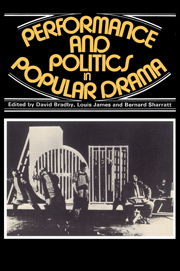 Performance and Politics in Popular Drama
Performance and Politics in Popular Drama Book contents
- Frontmatter
- Contents
- List of contributors
- Preface
- Acknowledgements
- PART ONE Spectacle, performance and audience in nineteenth-century theatre
- Introduction
- Was Jerrold's Black Ey'd Susan more popular than Wordsworth's Lucy?
- Word and image in Pixérécourt's melodramas: the dramaturgy of the strip-cartoon
- Joseph Bouchardy: a melodramatist and his public
- The music of melodrama
- Popular theatre in Victorian Birmingham
- Water drama
- Equestrian drama and the circus
- Theatre of war: the Crimea on the London stage 1854–5
- Popular drama and the mummers' play
- PART TWO Politics and performance in twentieth-century drama and film
- PART THREE Problems and prospects
- Appendix: Tempo, Tempo
- Select bibliography
- General index
- Index of titles of plays, films, sketches
- Index of theatres, theatre companies and groups
Introduction
Published online by Cambridge University Press: 08 March 2010
- Frontmatter
- Contents
- List of contributors
- Preface
- Acknowledgements
- PART ONE Spectacle, performance and audience in nineteenth-century theatre
- Introduction
- Was Jerrold's Black Ey'd Susan more popular than Wordsworth's Lucy?
- Word and image in Pixérécourt's melodramas: the dramaturgy of the strip-cartoon
- Joseph Bouchardy: a melodramatist and his public
- The music of melodrama
- Popular theatre in Victorian Birmingham
- Water drama
- Equestrian drama and the circus
- Theatre of war: the Crimea on the London stage 1854–5
- Popular drama and the mummers' play
- PART TWO Politics and performance in twentieth-century drama and film
- PART THREE Problems and prospects
- Appendix: Tempo, Tempo
- Select bibliography
- General index
- Index of titles of plays, films, sketches
- Index of theatres, theatre companies and groups
Summary
Contemporary interest in popular drama is not an adventitious one. It is part of a much wider shift in the basis of cultural concern; indeed, it is part of the revaluation of modern society itself. This gives the present study both its impetus and its difficulty. We not only approach areas of theatre that have previously been neglected, but we have to find appropriate critical terms which take into account the contemporary cultural debate. We have to be exploratory; yet we have to find some sense of direction or we will be lost.
In the past, popular drama has been studied under at least four categories, which have often been deployed within, or have relied for their specification upon, a quasi-chronological account. The first, which we may call folk drama, is related to a pre-literate, rural society. It is traditional, close to ritual and the everyday life of the common people. Industrialism and the growth of cities in the nineteenth century broke up the older genre. Large theatres were built to entertain the masses, exploiting possibilities of spectacle and sensation, and the star actor. This was the era of commercial workingclass theatre, music hall and melodrama. But the division of theatre along lines of the class of the audience was always uncertain, and with the development of film and then television we arrive at the period of mass media. In reaction to this, the radical elite created agit-prop theatre, attempting to restore drama to the people as part of the class struggle.
These categories and accounts are useful as far as they go, but they hide some dangerous assumptions.
- Type
- Chapter
- Information
- Performance and Politics in Popular DramaAspects of Popular Entertainment in Theatre, Film and Television, 1800–1976, pp. 1 - 2Publisher: Cambridge University PressPrint publication year: 1980


